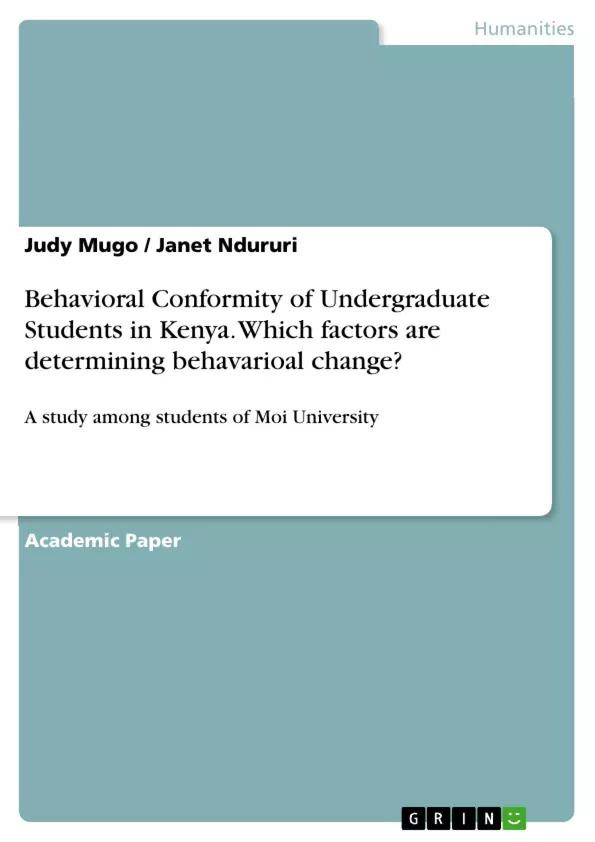When a person joins a social organization, it is imperative that they adapt to prosper. Change of values ordinarily occurs through compliance where one entertains and accepts the influence of comrades as they hope for favorable reactions from peers.
This study was an examination of behavioral change in response to customary university values and roles) among students of Moi University main campus. The key objective was to examine factors determining behavioral change among students in Moi University. It examined the adaptive behavioral responses of students to university environmental impediments and explored strategies to encourage positive behavior development.
The paper argues that students are disposed to adopt negative behavior at the University. The majority of students have inadequate fortitude and emotional intelligence to confront challenges inherent in the university environment. University rules and administration have range bound consequences on the behavior of students. The paper recommends the re-structuring of freshman orientation programs, peer mentorship, increased facilitation of student clubs and extracurricular activities, institutional recognition and awarding of outstanding students, and reconstitution of the university counseling program.
Inhaltsverzeichnis (Table of Contents)
- 1.0 INTRODUCTION.
- Sources of influence to change in the University.
- Behavior change process
- Learning and behavior change...
- Role of society in influencing behavioral change.
- Behavioral adaptation of newcomer students
- Self-esteem and student behavior change ......
- Personality and behavior change....
- Counseling as a tool for facilitating positive change
- 2.0 STATEMENT OF THE PROBLEM
- Objectives of the study ...
- 3.0 THEORETICAL FRAMEWORK
- Theory of planned behavior and Theory of reasoned action
- 4.0 STUDY MATERIALS AND METHODS
- Study area
- Methodology.
- 5.0 FINDINGS AND DISCUSSIONS.
- University rules and regulations
- Academics versus ‘hanging out'.
- Substance use and cohabitation.
- Intervention strategies for positive behavioral adaptation….......
Zielsetzung und Themenschwerpunkte (Objectives and Key Themes)
This study investigates the behavioral changes undergraduate students undergo while adapting to the unique social environment of a Kenyan university. The central objective is to identify factors that influence these changes, specifically examining the adaptive responses to university environmental impediments and exploring strategies to foster positive behavior development.
- The impact of university culture and norms on student behavior.
- The role of peer influence and social conformity in shaping student behavior.
- The influence of university rules and regulations on student behavior.
- Strategies for promoting positive behavioral change in a university setting.
- The challenges faced by students in adapting to the university environment.
Zusammenfassung der Kapitel (Chapter Summaries)
The study begins with an introduction that sets the context for the research, outlining the dynamic nature of human behavior and the importance of adaptation within social organizations. The authors delve into the process of behavioral change, exploring the influence of social, psychological, and environmental factors, as well as the impact of self-esteem and personality on adaptation. Chapter two presents the problem statement, focusing on the objectives of the study and the specific challenges faced by students at Moi University. Chapter three outlines the theoretical framework underpinning the study, drawing upon the Theory of Planned Behavior and the Theory of Reasoned Action. Chapter four provides a detailed account of the study materials and methods, including the research area and methodology. Finally, Chapter five presents the findings and discussions, analyzing the effects of university rules and regulations, the tension between academics and social activities, substance use and cohabitation, and exploring intervention strategies for positive behavioral adaptation.
Schlüsselwörter (Keywords)
The research revolves around the key concepts of university culture, student behavior, behavioral change, peer influence, social conformity, student culture, and adaptation strategies. The study focuses on identifying factors that influence student behavior within the university environment and proposes strategies to encourage positive behavioral development.
- Quote paper
- Judy Mugo (Author), Janet Ndururi (Author), 2016, Behavioral Conformity of Undergraduate Students in Kenya. Which factors are determining behavarioal change?, Munich, GRIN Verlag, https://www.grin.com/document/379330



